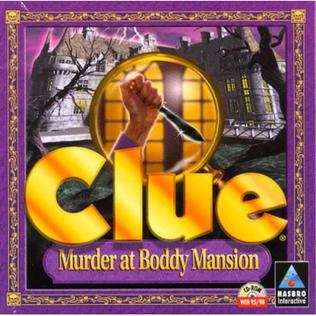
Clue is a 1998 video game based on the board game of the same name. It is also known as Clue: Murder at Boddy Mansion or Cluedo: Murder at Blackwell Grange, depending on whether the country of release used American or British English.

Neverwinter Nights is a third-person role-playing video game developed by BioWare. Interplay Entertainment was originally set to publish the game, but financial difficulties led to it being taken over by Infogrames, who released the game under their Atari range of titles. It is the first installment in the Neverwinter Nights series and was released for Microsoft Windows on June 18, 2002. BioWare later released a Linux client in June 2003, requiring a purchased copy of the game to play. MacSoft released a Mac OS X port in August 2003.

Star Trek: The Next Generation – A Final Unity is an adventure game by Spectrum HoloByte, based on the Star Trek universe. It was released in 1995 for the DOS and later ported to the Macintosh. It puts the player in control of Captain Picard and his crew of the Enterprise D and features traditional point-and-click adventure gameplay as well as free-form space exploration, diplomatic encounters and tactical ship-to-ship combat.

Rise of the Robots is a fighting game released by Time Warner Interactive in 1994. Originally developed for the Amiga and DOS by Mirage's Instinct Design, it was ported to various video game consoles, including the Super NES, the Mega Drive, and the 3DO Interactive Multiplayer. The game includes a single-player mode in which the player assumes the role of the ECO35-2 Cyborg as he attempts to stop the Supervisor who takes over Electrocorp's facilities in Metropolis 4, and a two-player mode in which the second player controls a character chosen from among EC035-2's enemies.

The Journeyman Project is a time travel adventure computer game developed by Presto Studios.
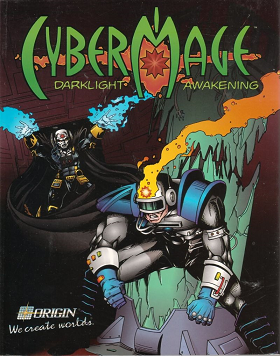
CyberMage: Darklight Awakening is a cyberpunk first-person shooter game with role-playing elements designed by David W. Bradley. It was created by Origin and released by Electronic Arts in 1995. The game is characterized by a dark, heavy atmosphere.
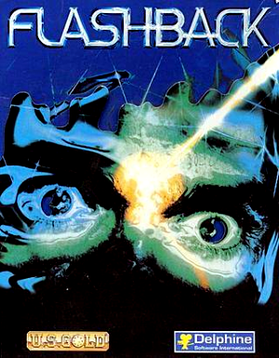
Flashback, released as Flashback: The Quest for Identity in the United States, is a 1992 science fiction cinematic platform game developed by Delphine Software of France and published by U.S. Gold in the United States and Europe, and Sunsoft in Japan.
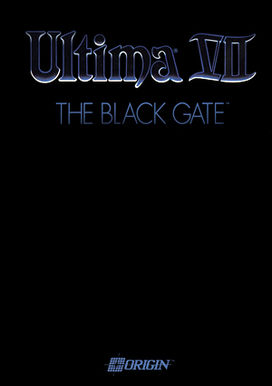
Ultima VII: The Black Gate is the seventh installment of the Ultima series of role-playing video games, released on April 16, 1992. In it, the player returns as The Avatar, a would-be paragon of moral virtue who faces down many dangers and deceptions in order to cleanse the medieval fantasy world of Britannia of assorted plots and schemes, monster infestations, and the undermining of crown authority.

Ultima Underworld: The Stygian Abyss is a first-person role-playing video game developed by Blue Sky Productions and published by Origin Systems. Released in March 1992, the game is set in the fantasy world of the Ultima series. It takes place inside the Great Stygian Abyss: a large cave system that contains the remnants of a failed utopian civilization. The player assumes the role of the Avatar—the Ultima series's protagonist—and attempts to find and rescue a baron's kidnapped daughter.

Crusader: No Remorse is an action game developed by Origin Systems and published by Electronic Arts. It was first released in 1995 for MS-DOS, with the Sony PlayStation and Sega Saturn ports following in 1997. Set in a dystopian future 22nd century, the game centers on The Captain, a special ops officer and supersoldier, who defects from the tyrannical world government, the World Economic Consortium (WEC), and joins the Resistance rebels.
An interactive film is a video game or other interactive media that has characteristics of a cinematic film. In the video game industry, the term refers to a movie game, a video game that presents its gameplay in a cinematic, scripted manner, often through the use of full-motion video of either animated or live-action footage.

The Daedalus Encounter is a 1995 interactive movie puzzle adventure game developed by Mechadeus and published by Virgin Interactive for Windows. The game was ported to the 3DO by Lifelike Productions and published by Panasonic. The premise of the game is that there are three space marines who have fought as part of an interstellar war. One of them, Casey, has been brought back to life by his partners after a space accident and he is now a brain grafted in a life-support system. In order to save themselves, the three characters and the player solve all sorts of puzzles.

War Gods is a fighting video game originally released to arcades by Midway Games in 1996. Ports for the Nintendo 64, PlayStation and Windows were released in 1997. In the game, players control one of ten fighters who have been given great power by a mysterious ore that crashed-landed on Earth from outer space. The object of the game is to defeat all the other fighters to become the most powerful warrior on the planet.
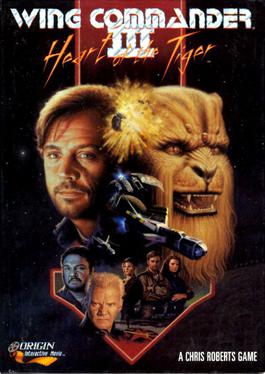
Wing Commander III: Heart of the Tiger is the third main game in Chris Roberts' Wing Commander science fiction space combat simulation video game series, developed and released by Origin Systems in December 1994. It was a departure from previous games in the series in that it uses extensive live action full-motion video to add an interactive movie-style presentation to the space combat gameplay, emphasized by its advertising slogan, "Don't watch the game, play the movie!". The game's more than two hours of video featured a number of prominent movie stars including Mark Hamill as Colonel Christopher "Maverick" Blair, Malcolm McDowell as Admiral Tolwyn, John Rhys-Davies as James "Paladin" Taggart and Thrakhath nar Kiranka, and Tom Wilson as Todd "Maniac" Marshall.
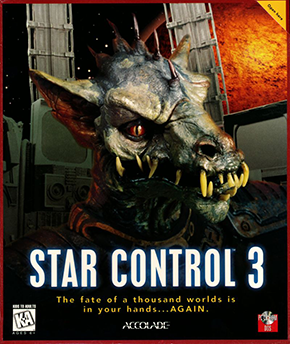
Star Control 3 is a 1996 action-adventure game developed by Legend Entertainment and published by Accolade. The third installment in the Star Control trilogy, the game was released for MS-DOS in 1996 and Mac OS in 1998. The story takes place after Star Control II, beginning with a disaster that disrupts superluminal travel through hyperspace. This leads the player to investigate a new quadrant of space, joined by allied aliens from the previous games.
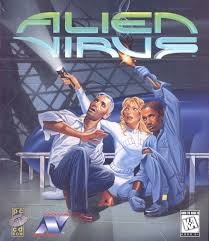
Alien Virus is a video game developed by Trecision and released in 1994 for MS-DOS.
Kenneth Llewellyn Demarest III is a computer game programmer, artist, and business person.

Star Trek: Voyager – Elite Force is a first-person shooter video game developed by Raven Software and published by Activision. The game was originally released on September 15, 2000 for Windows and Mac OS. A port for Mac OS developed by Westlake Interactive and published by Aspyr Media was released on November 20, 2002. Elite Force was ported to the PlayStation 2 by Pipe Dream Interactive and published by Majesco Entertainment on December 11, 2001.

A first-person shooter (FPS) is a video game centered on gun fighting and other weapon-based combat seen from a first-person perspective, with the player experiencing the action directly through the eyes of the main character. This genre shares multiple common traits with other shooter games, and in turn falls under the action games category. Since the genre's inception, advanced 3D and pseudo-3D graphics have proven fundamental to allow a reasonable level of immersion in the game world, and this type of game helped pushing technology progressively further, challenging hardware developers worldwide to introduce numerous innovations in the field of graphics processing units. Multiplayer gaming has been an integral part of the experience, and became even more prominent with the diffusion of internet connectivity in recent years.

Alien Odyssey is an action-adventure game developed by Argonaut Software and published by Philips Media in 1995. The game features a mixture of first-person and third-person gameplay, with sequences involving shooter, adventure and puzzle mechanics. Alien Odyssey makes use of 3D rendering and full motion video cutscenes which were developed using the developer's proprietary B-Render graphics software. Upon release, the game received a mixed reception, with reviewers praising the visual presentation of the game, whilst critiquing the game's inconsistent mixture of game modes and short length.





















